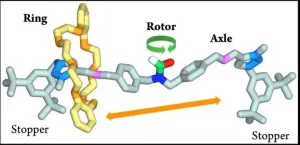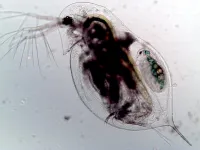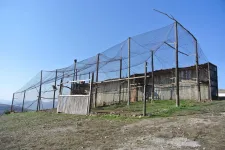Mechanics of the infinitely small: NanoGear, towards a molecular gear
2021-05-17
(Press-News.org) Gears and mechanical transmissions are at home in the Emilia-Romagna region, the Motor Valley of northern Italy. A team of researchers from the University of Bologna and the Institute for Organic Synthesis and Photoreactivity of the National Research Council (Cnr-Isof) in Bologna, led by Massimo Baroncini and Alberto Credi, has planned, constructed and operated NanoGear, a device consisting of interlocked molecular components and designed to function as a gear. Since molecules are nanometric objects (1 nanometer = 1 millionth of a millimetre), it is an exceedingly small device: certainly, the tiniest gear ever produced in the Italian land of motors.
"The transmission and transformation of nanometric movements in biological molecules are the basis of the main functions of living organisms. Nevertheless, these phenomena are poorly understood in artificial molecules because they are extremely difficult to identify and observe. The construction of molecular devices such as NanoGear is a first step forward towards the development of ultra-miniaturized mechanical devices based on molecular motors, with potential breakthrough applications in various fields of technology and medicine ", says Alberto Credi.
THE DEVICE
The NanoGear molecule belongs to the class of rotaxanes and consists of three components: a ring that can slide along an axle that bears a rotor installed in its centre.
"The ring is free to shuttle along the axle for its entire length, but it cannot escape because two bulky groups (stoppers) positioned at the ends of the axle prevent it from slipping off. The rotor is free to rotate around its own axis and has two different 'blades' to facilitate observation of the movement", explains Massimo Baroncini. "The main design element of NanoGear lies in the fact that the rotor is directly linked to the axis with a regular chemical (covalent) bond, whereas the ring is mechanically locked around the axis by the presence of the stoppers. Both the translation of the ring and the rotation of the rotor are random oscillations determined by the thermal energy of the molecule; in other words, the gear is not coupled to any motor and functions 'in neutral'. Sophisticated nuclear magnetic resonance techniques were used to observe the movements and measure their rates".
At 65 °C, the ring shuttles from one end of the axle to the other about 7 times per minute, passing over the rotor; in the same amount of time, the latter completes about 260 rotations. Therefore the two motions are not synchronized; however, they mutually influence each other, as demonstrated by experiments carried out on molecules similar to NanoGear but devoid of the rotor or the ring.
Another significant and unexpected result is the effect of the medium in which the molecule is dispersed: by changing the solvent, one of the two movements is slowed down, while the other is accelerated. Such a 'specific lubrication' finds no correspondence in the macroscopic world, and constitutes one of the unconventional properties of nanodevices that could lead to radical technological innovations.
THE PROJECT
Artificial molecular machines, awarded with the Nobel Prize in Chemistry in 2016, convert energy from a source into controlled nanoscale movements and are one of the most striking results of nanotechnology. In order to exploit these movements, however, passive elements capable of processing them and transmitting them to other components, as it happens in macroscopic devices, are necessary. In this research, chemists operate in the same way as engineers and architects, but manipulating objects a billion times smaller, since their building blocks are atoms and molecules.
NanoGear is the result of a project born about five years ago and is part of a research activity in which the Center for Light Activated Nanostructures (Clan), a joint laboratory of the University of Bologna and the Italian National Research Council, is an international reference point.
NanoGear was created with the support of an Advanced Grant from the European Research Council (ERC), the most prestigious and competitive grant for scientific research in Europe. In the past, the same laboratory had already attracted public attention by developing molecular-based pumps (Nature Nanotechnology, 2015) and sponges (Nature Chemistry, 2015) powered by light. The central role of the research performed in Bologna on the subject of molecular machines was recognized during the "MolecularMachinesDays" event, held in Bologna in November 2018 with the participation of the three 2016 Nobel laureates in Chemistry.
THE RESULTS
The realization of artificial devices consisting of molecules is of great interest for the development of nanotechnology. "As shown by the results obtained in recent years in laboratories worldwide, nanotechnology can provide us with lighter and stronger materials, smaller and more powerful computers and robots, better systems for transforming and storing energy, new methods for medical diagnostics and therapies", says Alberto Credi. "NanoGear is a small but significant step in this direction. While it is currently difficult to identify a specific use of NanoGear, the basic research that led to its development has a revolutionary potential for science and technology that goes far beyond short-term practical applications".
INFORMATION:
THE STUDY
The study has been published in the journal Chem with the title "Stereodynamics of E/Z isomerization in rotaxanes through mechanical shuttling and covalent bond rotation". The research has been carried out in the Center for Light Activated Nanostructures (Clan) under the guidance of University professors Alberto Credi (Department of Industrial Chemistry "Toso Montanari") and Massimo Baroncini (Department of Agricultural and Food Science and Technology). Stefano Corrà (Department of Industrial Chemistry "Toso Montanari"), Christiaan de Vet (Department of Agricultural and Food Science and Technology) and Serena Silvi (Department of Chemistry "Giacomo Ciamician") also contributed to the work.
[Attachments] See images for this press release:

ELSE PRESS RELEASES FROM THIS DATE:
2021-05-17
DALLAS, May 17, 2021 -- Detecting a critical heart defect before birth (congenital heart defects) is less likely when a mother lives in a rural area, lives in a neighborhood with low socioeconomic status or is Hispanic, according to new research published today in the American Heart Association's flagship journal Circulation.
Diagnosing a heart defect before birth reduces infant death rates, increases access to prompt medical treatment, improves neurodevelopmental outcomes and decreases the risk of brain injury for the infant after birth.
"The benefits of prenatal diagnosis for heart defects have been recognized for years, yet prenatal detection occurs in less than 60% of congenital heart disease cases in many U.S. ...
2021-05-17
A valve invented by engineer Nikola Tesla a century ago is not only more functional than previously realized, but also has other potential applications today, a team of researchers has found after conducting a series of experiments on replications of the early 20th-century design.
Its findings, reported in the journal Nature Communications, suggest that Tesla's device, which he called a "valvular conduit," could harness the vibrations in engines and other machinery to pump fuel, coolants, lubricants, and other gases and liquids.
Now known as the Tesla Valve, the patented device has inspired strategies for ...
2021-05-17
A study published in the scientific journal Addiction provides the most comprehensive evidence to date of the association between recreational cannabis laws (RCLs) in US states and responses in the illegal markets for cannabis, heroin, and other drugs in those states.
As of 2021, 17 US states and the District of Columbia have implemented RCLs that allow people aged 21 and older to possess, use and supply limited amounts of cannabis for recreational purposes. This study found that the implementation of RCLs was associated with the following responses in the illegal drug market in those states:
9.2% decrease in street/illegal cannabis ...
2021-05-17
Scientists have proposed the first steps towards a united global plan to save our oceans, for the sake of human health.
An interdisciplinary European collaboration called the Seas Oceans and Public Health In Europe (SOPHIE) Project, led by the University of Exeter and funded by Horizons 2020, has outlined the initial steps that a wide range of organisations could take to work together to protect the largest connected ecosystem on Earth. In a commentary paper published in the American Journal of Public Health the researchers call for the current UN Ocean Decade to act as a meaningful catalyst for global change, reminding us that ocean ...
2021-05-17
In its response to pathogens and vaccines, our immune system relies on dendritic cells. These white blood cells patrol the body's tissues, collect components of pathogens and vaccines and transport them via lymphatic vessels to the nearest lymph node. There, they present the collected material to other immune cells in order to trigger an immune response.
How exactly dendritic cells get from the tissue into lymphatic vessels and from there to the lymph node is the focus of research conducted by Cornelia Halin, Professor of Pharmaceutical Immunology at ETH Zurich. For a long ...
2021-05-17
ANN ARBOR, Mich. -- For children, pandemic norms have meant virtual school, holidays over Zoom and for some, even seeing the doctor from their own homes.
One in five parents in a new national poll say their child had a virtual health visit over the past year for either check-ups, minor illnesses, mental health or a follow up - a marked increase in remote care for children.
And while some parents still have reservations about using telemedicine for their kids, the majority were satisfied with the experience, suggest findings from the C.S. Mott Children's Hospital National Poll on Children's Health at the University of Michigan.
"COVID has had a major impact ...
2021-05-17
Indigenous peoples in Canada have higher rates of death and complications after surgery and lower rates of surgeries than other populations, found new research published in CMAJ (Canadian Medical Association Journal).
"Understanding surgical outcomes and access to surgical services is a vital step toward addressing colonialism and structural racism within health care, so we can identify the gaps and determine what needs to be improved," said Dr. Nadine Caron, a general surgeon in Prince George and co-director of the Centre for Excellence in Indigenous Health ...
2021-05-17
Hamilton, ON (May 17, 2021) - Boys born weighing less than a kilogram are miracles, but they do not age as well as the girls, according to new research from McMaster University.
Researchers following a group of extremely low birth weight (ELBW) babies as well as their normal weight counterparts have found that, at least biologically, the premature or preemie boys age more quickly and are 4.6 years older than boys with normal birth weight born at the same time. The difference was not found between birth weight groups in girls.
In the study published in the journal Pediatrics today, the researchers point out that the rate of aging may be influenced by boys' handling ...
2021-05-17
Whether it's plankton exposed to parasites or people exposed to pathogens, a host's initial immune response plays an integral role in determining whether infection occurs and to what degree it spreads within a population, new University of Colorado Boulder research suggests.
The findings, published May 13 in The American Naturalist, provide valuable insight for understanding and preventing the transmission of disease within and between animal species. From parasitic flatworms transmitted by snails into humans in developing nations, to zoonotic spillover events from mammals and insects to humans--which have caused ...
2021-05-17
Fifty years after presumably becoming extinct as a breeding species in Bulgaria, the Griffon Vulture, one of the largest birds of prey in Europe, is back in the Eastern Balkan Mountains. Since 2009, three local conservation NGOs - Green Balkans - Stara Zagora, the Fund for Wild Flora and Fauna and the Birds of Prey Protection Society, have been working on a long-term restoration programme to bring vultures back to their former breeding range in Bulgaria. The programme is supported by the Vulture Conservation Foundation, the Government of Extremadura, Spain, and EuroNatur. Its results have been described in the open-access, peer-reviewed Biodiversity Data Journal.
Two large-scale projects funded by the EU's LIFE tool, one of them ongoing, facilitate the import of captive-bred or ...
LAST 30 PRESS RELEASES:
[Press-News.org] Mechanics of the infinitely small: NanoGear, towards a molecular gear





